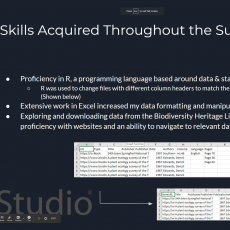
Invasive plant species are pervasive through the United States, causing severe damage to the ecosystems they invade. A large portion of these species were originally imported as ornamental plants that then escaped cultivation to spread in natural areas. While the introduction date and location for many invasive plants is known, the pattern of their spread following introduction is not well-documented. Therefore, this project aims to use archived nursery catalogs to analyze the relationship between past horticultural introductions and present plant invasions. Specifically, we can compare the locations of invasive plant distributions to the locations of nurseries selling these species over time as a way of testing if it is possible that these nurseries contributed to invasive species outbreaks.
The first step of this project was to find and compile data sources for nursery catalogs that contain invasive plants. Each year, plant nurseries send catalogs to their customers as a way to inform them of the seeds and other products they will be selling that season. These catalogs have been archived by several sources, such as The Biodiversity Heritage Library, which is managed by the University of Minnesota. This database has a collection of seed catalogs from the late 1800’s through the late 1900’s. The collection allows us to go back in time and see where invasive species are being sold throughout the continental United States of America.
I started this internship in the spring of 2020 with the goal of finding a collection of nursery catalogs that would provide us with the data we needed to complete this project. For example, to track horticultural introductions over time and space, we needed to find nursery catalogs that had dates and locations as well as lists of plant names sold by that nursery. I spent this semester reading and establishing an annotated bibliography on information about invasive plants and their spread as ornamentals. I learned new concepts such as the naming system of non-indigenous plant species, and propagule pressure, which is the hypothesis that the more invasive species you introduce to a location, the more likely that species is to establish and spread. After the baseline knowledge was established, I started exploring different nursery catalog collections. We chose the Biodiversity Heritage Library because it contained the most data, was stored in a user-friendly platform and was easily downloadable in bulk.
This summer I worked on data collection and analysis of nursery catalogs while also participating in Dr. Bethany Bradley’s lab group. We downloaded thousands of nursery catalogs that contained information about roughly 1,000 invasive plant species. My job was to conduct preliminary data exploration to decide if the data set contained the information we were interested in for a variety of species. I worked on compiling these data and used R, a programming language, to clean all the files to be combined.
These activities contributed to the goal and objectives of the project by identifying and creating a data set that can be used to test our main hypothesis. The next steps are to continue cleaning the data, adding spatial information, and mapping the horticultural introductions for each species. Therefore, over this coming semester, the goal is producing several maps that show the areas an invasive plant has been sold over time compared to the areas that they have invaded.
This project gave me a deep understanding of the intricacies of working in academia, such as working towards a masters or doctorate degree, analyzing data, and giving me the opportunity to learn how to write code in a programming language. This helped advance my future goals by giving me hard skills that I can continue to practice to make me more employable later in my life, as well as helping me practice soft skills. These hard skills involve a lot of technical work. I learned to work with the programming language R and have an understanding of Python. The work with the data files allowed me to practice my already consistent skills with Excel. I practiced my ability to read and understand scientific papers. The soft skills I got to practice fall into communication, time management, and public (albeit online) speaking. The experience gained through working with the invasive ecology lab group this summer has been exponential and their feedback on my project has and will be a great addition to my research experience.
